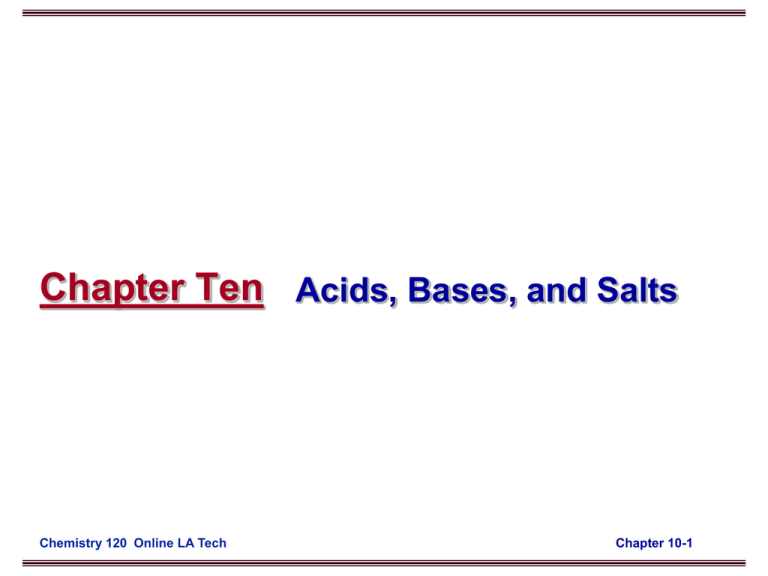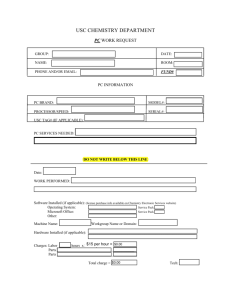chapter-10-stoker
advertisement

Chapter Ten Acids, Bases, and Salts Chemistry 120 Online LA Tech Chapter 10-1 Acidity of the water matters → CO 10.1 Fish are very sensitive to the acidity of the water present in an aquarium. © Bios/Yvette Tavernier/Peter Arnold Inc. Chemistry 120 Online LA Tech Chapter 10-2 In water acids and bases dissociate Fig. 10.1 The difference between the aqueous solution processes of ionization and dissociation. Chemistry 120 Online LA Tech Chapter 10-3 Litmus changed color in acids and bases → Fig. 10.2 Litmus is a vegetable dye obtained from certain lichens found principally in the Netherlands. Chemistry 120 Online LA Tech Chapter 10-4 Some acids and bases reactions does not require water ← Fig. 10.3 A white cloud of finely divided solid NH4Cl is produced by the acid-base reaction that results when the colorless gases HCl and NH3 mix. Ken O’Donoghue © Houghton Mifflin Company Chemistry 120 Online LA Tech Chapter 10-5 Acid and base strengths and pH Table 10.1 Chemistry 120 Online LA Tech Chapter 10-6 Acids tastes sour → Fig. 10.4 The sour taste of limes and other citrus fruit is due to the citric acid present in the fruit juice. Chemistry 120 Online LA Tech Chapter 10-7 Ka for some acids and ions Table 10.2 Chemistry 120 Online LA Tech Chapter 10-8 Weak acids have fewer ions Fig. 10.5 A comparison of the number of acidic species present in strong acid and weak acid solutions of the same concentration. Chemistry 120 Online LA Tech Chapter 10-9 Hydroxy bases of group IA and IIA ← Table 10.3 Chemistry 120 Online LA Tech Chapter 10-10 Ka and percent ionization Table 10.4 Chemistry 120 Online LA Tech Chapter 10-11 Acid and base reactions produce salts → Fig. 10.6 The acid-base reaction between sulfuric acid and barium hydroxide produces the insoluble salt barium sulfate. Chemistry 120 Online LA Tech Chapter 10-12 Neutralization is water formation Fig. 10.7 Formation of water by the transfer of protons from H3O+ ion to OH- ions. Chemistry 120 Online LA Tech Chapter 10-13 Common anti-acids CC 10.1 Chemistry 120 Online LA Tech Chapter 10-14 H3O+ and OH- ion concentrations flip-flop Fig. 10.9 The relationship between H3O+ and OH- in aqueous solution is an inverse proportion. Chemistry 120 Online LA Tech Chapter 10-15 [H3O+] and [OH-] ion product is constant Table 10.5 Chemistry 120 Online LA Tech Chapter 10-16 pH of aqueous solutions → Fig. 10.10 Most fruits and vegetable are acidic. Chemistry 120 Online LA Tech Chapter 10-17 [H3O+] and [OH-] ion concentrations ← Fig. 10.11 Relationship among pH values, H3O+ and OH- at 24 degrees Celsius . Chemistry 120 Online LA Tech Chapter 10-18 pH of different solutions → Fig. 10.12 pH values of selected common liquids. Chemistry 120 Online LA Tech Chapter 10-19 pH meter is helpful Fig. 10.13 A pH meter gives an accurate measurement of pH values. Chemistry 120 Online LA Tech Chapter 10-20 pH of body fluids ← Table 10.6 Chemistry 120 Online LA Tech Chapter 10-21 Acidity/basicity of salt solutions Table 10.7 Chemistry 120 Online LA Tech Chapter 10-22 Summary of acids CAG 10.1 Chemistry 120 Online LA Tech Chapter 10-23 Acidity of various solutions ← CC 10.2 Acid Rain Chemistry 120 Online LA Tech Chapter 10-24 Predicting pH of salts solutions Table 10.8 Chemistry 120 Online LA Tech Chapter 10-25 Buffers solutions compared to unbuffered Table 10.9 Chemistry 120 Online LA Tech Chapter 10-26 Buffers solutions compared to unbuffere Ken O’Donoghue © Houghton Mifflin Company Ken O’Donoghue © Houghton Mifflin Company Fig. 10.14 (a) The buffered and unbuffered solutions have the same pH level. Fig. 10.14 (b) After adding 1mL of a 0.01 M HCl solution, the pH of the buffered solution has not perceptibly changed, but the unbuffered solution has become acidic. Chemistry 120 Online LA Tech Chapter 10-27 How buffers are made? CAG 10.2 Chemistry 120 Online LA Tech Chapter 10-28 pH of blood. Does it matters? CC 10.4 Chemistry 120 Online LA Tech Chapter 10-29 How you tell something is an electrolytes, weak electrolytes, or nonelectrolyte? Fig. 10.15 This simple device can be used to distinguish among strong electrolytes, weak electrolytes, and nonelectrolytes. Chemistry 120 Online LA Tech Chapter 10-30 Acids/base titrations: How you do it? ← Fig. 10.16 Diagram showing setup for titration procedures. Chemistry 120 Online LA Tech Chapter 10-31 Electrolytes in Body Fluids CC 10.5 Electrolyte and Body Fluids Chemistry 120 Online LA Tech Chapter 10-32 How does indicator show the end point? Fig. 10.17 An acid-base titration using an indicator that is yellow in acidic solution and red in basic solution. Chemistry 120 Online LA Tech Chapter 10-33





